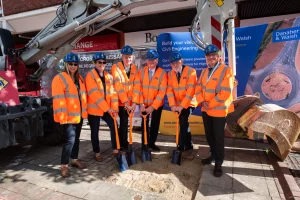In an era where global temperatures are rapidly escalating, and the dire impacts of climate change become more discernible, the Public Sector Decarbonisation Scheme (PSDS) has been introduced to aid in sculpting a more sustainable and resilient nation by 2050.
From retrofitting heat pumps to enhancing insulation and championing renewable energy, the journey has begun. However, this initiative isn’t solely about technology or infrastructure. It’s about evolution, a cultural metamorphosis that deeply ingrains the essence of sustainability in our ethos.
In this Article, Key Account Manager (East) Tom Woolley, with expert commentary from CPW, breaks down Phase 3c of the Public Sector Decarbonisation Scheme, including funding availability and essential implementation dates.
The history of PSDS
Designed to create a more sustainable and resilient UK by 2050, this initiative highlights the critical role of public institutions in leading the charge for a greener future.
What’s the significance of targeting the public sector, you may ask? Consider this: the buildings we learn in, the places that heal us, and the local facilities we visit contribute immensely to the country’s carbon footprint. The PSDS recognises their potential as key players in the sustainability revolution.
The PSDS has been empowering these vital institutions to embrace greener operations. With the support of Salix Finance and guidance from the Department for Business, Energy & Industrial Strategy (BEIS), public entities have embarked on a series of decarbonisation efforts like retrofitting heat pumps, enhancing insulation, and integrating renewable energy solutions.
Beyond just funding and infrastructure, the PSDS has ignited a cultural shift. It’s not merely about adapting to new technologies; it’s about fostering a mindset that values and prioritises sustainability at every turn.
We asked Hannah Kissick, Associate at low carbon consultancy Couch Perry Wilkes, her thoughts on what is required to create a sustainable future.
“Investing in a sustainable future demands more than current capital; it calls for unwavering commitment, both public and private, to truly achieve our net zero ambitions before the climate crisis deepens.”
Funding decarbonisation for public sector projects
Many public sector buildings continue to use fossil fuels for heating, hot water, and catering needs. The Public Sector Decarbonisation Scheme emphasises reducing carbon emissions from heating, adopting a comprehensive approach to the entire building.
Phase 3c of this scheme enhances the initiatives set in Phases 3a and 3b, incorporating adjustments based on stakeholder feedback about the distribution of funds over different financial years. Additionally, the scheme is committed to distributing funds equitably among projects in various sectors.
The Department has approved an extra year of funding for Phase 3c of the Public Sector Decarbonisation Scheme. This additional funding not only augments the scheme’s total financial support but also allows Phase 3c projects to span two fiscal years. For the 2024/25 year, up to £230 million is allocated for Phase 3c. The budget for 2025/26 will be finalized this autumn, but applicants should anticipate a roughly even distribution of funds between 2024/25 and 2025/26.
The scheme, delivered by Salix Finance, gives applicants the opportunity to submit separate applications for different projects or combine several projects into a single application for projects being delivered across one or two financial years. The key features of Phase 3c are set out in section 2 of this guidance document.
Applications fall into one of three sector categories: education, health, or other.
Education covers state primary and secondary schools, universities, and applications by local authorities for schools. Leisure facilities owned by educational entities are also included.
Health comprises hospitals and health centres.
Other encompasses services like emergency and ambulance services, local authorities, clubs, leisure and community centres, law courts, prisons, Ministry of Defence buildings, museums, and theatres. Mixed applications, like one from a local authority for both a school and leisure centre, are categorized here. For Phase 3c, ambulance services are also classified under ‘other’.
Key dates for delivery:
Application: Set to open on the 10/10/2023 for 10 days.
Application Form: Application forms are available for download on the Salix Finance website. Applicants can submit individual forms for different projects or consolidate multiple projects into one application.
Outcome: Applicants will be notified of their application status by the end of March 2024.
Project Completion: Projects receiving funding should finalise by 31 March 2026. Those with multi-year grants need to evidence their expenses annually.
Grant spending timeframe:
Phase 3c of the Public Sector Decarbonisation Scheme allows projects to span over two financial years for increased flexibility. This emphasizes a ‘whole building’ approach for enhanced carbon savings. Applicants should provide a funding profile tailored to their project’s timeline. For instance, projects can stretch over two financial years, ending by autumn 2025, but all must finish by 31 March 2026. Applications solely for the 2024/25 financial year are still accepted.
Applicants must include a grant spending profile in their applications. Once submitted, changes to this profile, such as shifting funds between years, cannot be made unless approved by Salix Finance during the assessment phase. The agreed grant spending remains fixed, with no modifications permitted after signing the Grant Offer Letter. Just like in Phase 3b, projects can solely spend in 2025/26, using 2024/25 for planning, which offers more planning time with guaranteed funding.
Project criteria
Applicants should use a ‘whole building’ method for decarbonisation, viewing energy factors in a comprehensive manner to identify cost-effective solutions. Enhancing a building’s thermal performance can decrease the size of the required low carbon heating system, save on energy bills, and boost occupant comfort. Investing in electricity consumption reduction, like using energy-efficient lighting, can prevent the need for upgrading electrical systems when installing a heat pump.
Applications will be evaluated based on how thoroughly a building’s total energy use is considered when choosing installation measures.
Eligible measures are split into four distinct areas:
Low carbon measures that save direct carbon: Low carbon heating systems that include the following measures: Air source heat
pump, water source heat pump, ground source heat pump, electric heating and hot water, solar thermal and a connection to existing district heating.
Other measures that save direct carbon: Measures that contribute to saving direct carbon; for example, building fabric upgrades, pipework insulation and mechanical ventilation heat recovery.
Measures that save indirect carbon: Measures that only save indirect carbon (typically electricity savings) such as
solar PV, LED lighting and energy efficient ventilation.
Enabling measures: Measures that do not save carbon but enable the installation of measures
that do. This can include measures such as electrical infrastructure upgrades,energy storage, and smart meters etc.
Further criteria:
1. Additionality Criteria: Projects must be ‘additional’ and indicate this on the Application Portal. Projects with private funding equal to or more than the project’s cost are ineligible. All other private funding avenues should have been considered.
2. Like-for-like Cost & Contribution: Applicants must cover the costs of replacing their fossil fuel systems, set at a minimum of 12% of total project costs. If actual replacement costs exceed 12%, they must cover that higher percentage.
3. Whole Building Approach: All buildings in the application should adopt this approach, examining the steps taken to reduce heating demand for low flow temperature heating systems. Measures for each building should be distinctly outlined in the Application Form.
4. Energy Efficiency Measures: Funds from the Public Sector Decarbonisation Scheme can’t be used for energy measures in buildings not connected to the proposed low carbon heating system. But installations of smart meters are acceptable.
5. Energy Efficiency Cap: There’s a maximum of 58% of the total grant value that can be claimed for energy efficiency.
6. Hybrid Heating Systems: The current phase doesn’t support hybrid systems that include new fossil fuel boilers. However, combining different low-carbon heating systems is acceptable. The new systems must meet the same heat demand as the replaced systems.
7. Grant Start Date: Once the grant is approved, work can begin upon signing the Grant Offer Letter, even if it’s before 31 March 2024. However, funds cannot be claimed for work done before the signing. If applicants can start before 1 April 2024, it should be indicated in their application.
Next steps
Procure Partnerships Framework operates Decarbonisation and Retrofit lots across nine regions, offering local solutions and specialist contractors for each and every scheme.
Clients benefit from the framework’s flexibility, with options for Direct Award, Single or Two-Stage procurement and up to eight call-off contracts. With specialist expertise in procurement and construction for the public sector, the framework stands as a reliable nationally focused service, supporting clients throughout a project’s lifecycle.
Contractors really are the linchpin in our journey towards sustainability. Their expertise and dedication transform client visions into tangible, on-the-ground progress, leading us closer to our net zero aspirations. Through the framework’s Decarbonisation and Retrofit lots our Contractor Partners are equipped to deliver all works funded by the Public Sector Decarbonisation Scheme.
To learn more about the Public Sector Decarbonisation Scheme and how we can help, contact us at info@procurepartnerships.co.uk or call 0333 577 7575.



